Raevenlord
News Editor
- Joined
- Aug 12, 2016
- Messages
- 3,755 (1.24/day)
- Location
- Portugal
| System Name | The Ryzening |
|---|---|
| Processor | AMD Ryzen 9 5900X |
| Motherboard | MSI X570 MAG TOMAHAWK |
| Cooling | Lian Li Galahad 360mm AIO |
| Memory | 32 GB G.Skill Trident Z F4-3733 (4x 8 GB) |
| Video Card(s) | Gigabyte RTX 3070 Ti |
| Storage | Boot: Transcend MTE220S 2TB, Kintson A2000 1TB, Seagate Firewolf Pro 14 TB |
| Display(s) | Acer Nitro VG270UP (1440p 144 Hz IPS) |
| Case | Lian Li O11DX Dynamic White |
| Audio Device(s) | iFi Audio Zen DAC |
| Power Supply | Seasonic Focus+ 750 W |
| Mouse | Cooler Master Masterkeys Lite L |
| Keyboard | Cooler Master Masterkeys Lite L |
| Software | Windows 10 x64 |
AMD has been on a roll in both consumer, professional, and exascale computing environments, and it has just snagged itself another hugely important contract. The US Department of Energy (DOE) has just announced the winners for their next-gen, exascale supercomputer that aims to be the world's fastest. Dubbed "El Capitan", the new supercomputer will be powered by AMD's next-gen EPYC Genoa processors (Zen 4 architecture) and Radeon GPUs. This is the first such exascale contract where AMD is the sole purveyor of both CPUs and GPUs, with AMD's other design win with EPYC in the Cray Shasta being paired with NVIDIA graphics cards.
El Capitan will be a $600 million investment to be deployed in late 2022 and operational in 2023. Undoubtedly, next-gen proposals from AMD, Intel and NVIDIA were presented, with AMD winning the shootout in a big way. While initially the DOE projected El Capitan to provide some 1.5 exaflops of computing power, it has now revised their performance goals to a pure 2 exaflop machine. El Capitan willl thus be ten times faster than the current leader of the supercomputing world, Summit.
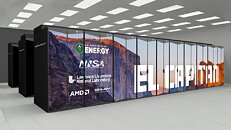
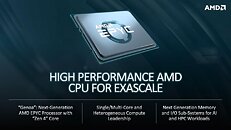
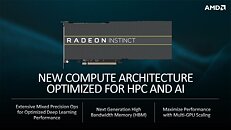
AMD's ability to provide an ecosystem with both CPUs and GPUs very likely played a key part in the DOE's choice for the project, and this all but guarantees that the contractor was left very satisfied with AMD's performance projections for both their Zen 4 and future GPU architectures. AMD's EPYC Genoa will feature support next-gen memory, implying DDR5 or later, and also feature unspecified next-gen I/O connections. AMD's graphics cards aren't detailed at all - they're just referred to as being part of the Radeon instinct lineup featuring a "new compute architecture".
Another wholly important part of this design win has to be that AMD has redesigned their 3rd Gen Infinity Fabric (which supports a 4:1 ratio of GPUs to CPUs) to provide data coherence between CPU and GPU - thus effectively reducing the need for data to move back and forth between the CPU and GPU as it is being processed. With relevant data being mirrored across both pieces of hardware through their coherent, Infinity Fabric-powered memory, computing efficiency can be significantly improved (since data transition usually requires more power expenditure than the actual computing calculations themselves), and that too must've played a key part in the selection.
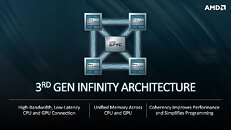
El Capitan will also feature a future version of CRAY's proprietary Slingshot network fabric for increased speed and reduced latencies. All of this will be tied together with AMD's ROCm open software platform for heterogeneous programming to maximize performance of the CPUs and GPUs in OpenMP environments. ROCm has recently gotten a pretty healthy, $100 million shot in the arm also courtesy of the DOE, having deployed a Center of Excellence at the Lawrence Livermore National Lab (part of the DOE) to help develop ROCm. So this means AMD's software arm too is flexing its muscles - for this kind of deployment, at least - which has always been a contention point against rival NVIDIA, who has typically shown to invest much more in its software implementations than AMD - and hence the reason NVIDIA has been such a big player in the enterprise and computing segments until now.
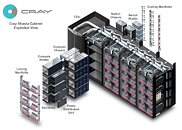

As for why NVIDIA was shunned, it likely has nothing to do with their next-gen designs offering lesser performance than what AMD brought to the table. If anything, I'd take an educated guess in that the 3rd gen Infinity Fabric and its memory coherence was the deciding factor in choosing AMD GPUs over NVIDIA's, because the green company doesn't have anything like that to offer - it doesn't play in the x64 computing space, and can't offer that level of platform interconnectedness. Whatever the reason, this is yet another big win for AMD, who keeps muscling Intel out of very, very lucrative positions.
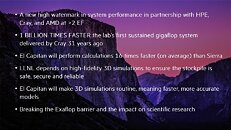
View at TechPowerUp Main Site
El Capitan will be a $600 million investment to be deployed in late 2022 and operational in 2023. Undoubtedly, next-gen proposals from AMD, Intel and NVIDIA were presented, with AMD winning the shootout in a big way. While initially the DOE projected El Capitan to provide some 1.5 exaflops of computing power, it has now revised their performance goals to a pure 2 exaflop machine. El Capitan willl thus be ten times faster than the current leader of the supercomputing world, Summit.



AMD's ability to provide an ecosystem with both CPUs and GPUs very likely played a key part in the DOE's choice for the project, and this all but guarantees that the contractor was left very satisfied with AMD's performance projections for both their Zen 4 and future GPU architectures. AMD's EPYC Genoa will feature support next-gen memory, implying DDR5 or later, and also feature unspecified next-gen I/O connections. AMD's graphics cards aren't detailed at all - they're just referred to as being part of the Radeon instinct lineup featuring a "new compute architecture".
Another wholly important part of this design win has to be that AMD has redesigned their 3rd Gen Infinity Fabric (which supports a 4:1 ratio of GPUs to CPUs) to provide data coherence between CPU and GPU - thus effectively reducing the need for data to move back and forth between the CPU and GPU as it is being processed. With relevant data being mirrored across both pieces of hardware through their coherent, Infinity Fabric-powered memory, computing efficiency can be significantly improved (since data transition usually requires more power expenditure than the actual computing calculations themselves), and that too must've played a key part in the selection.

El Capitan will also feature a future version of CRAY's proprietary Slingshot network fabric for increased speed and reduced latencies. All of this will be tied together with AMD's ROCm open software platform for heterogeneous programming to maximize performance of the CPUs and GPUs in OpenMP environments. ROCm has recently gotten a pretty healthy, $100 million shot in the arm also courtesy of the DOE, having deployed a Center of Excellence at the Lawrence Livermore National Lab (part of the DOE) to help develop ROCm. So this means AMD's software arm too is flexing its muscles - for this kind of deployment, at least - which has always been a contention point against rival NVIDIA, who has typically shown to invest much more in its software implementations than AMD - and hence the reason NVIDIA has been such a big player in the enterprise and computing segments until now.


As for why NVIDIA was shunned, it likely has nothing to do with their next-gen designs offering lesser performance than what AMD brought to the table. If anything, I'd take an educated guess in that the 3rd gen Infinity Fabric and its memory coherence was the deciding factor in choosing AMD GPUs over NVIDIA's, because the green company doesn't have anything like that to offer - it doesn't play in the x64 computing space, and can't offer that level of platform interconnectedness. Whatever the reason, this is yet another big win for AMD, who keeps muscling Intel out of very, very lucrative positions.

View at TechPowerUp Main Site







 Nv just practices the Apple model of separable markets. Perennially cash strapped departments get reduced price HW with decent devrel support for academic/student research that can be generated quickly with reproducible results. Nv gets exposure via publications, students require CUDA once back ITRW, Nv gets to sell Quadros/Teslas to business/govt. Path of least resistance, virtuous circle, only game in town? Take your pick.
Nv just practices the Apple model of separable markets. Perennially cash strapped departments get reduced price HW with decent devrel support for academic/student research that can be generated quickly with reproducible results. Nv gets exposure via publications, students require CUDA once back ITRW, Nv gets to sell Quadros/Teslas to business/govt. Path of least resistance, virtuous circle, only game in town? Take your pick.